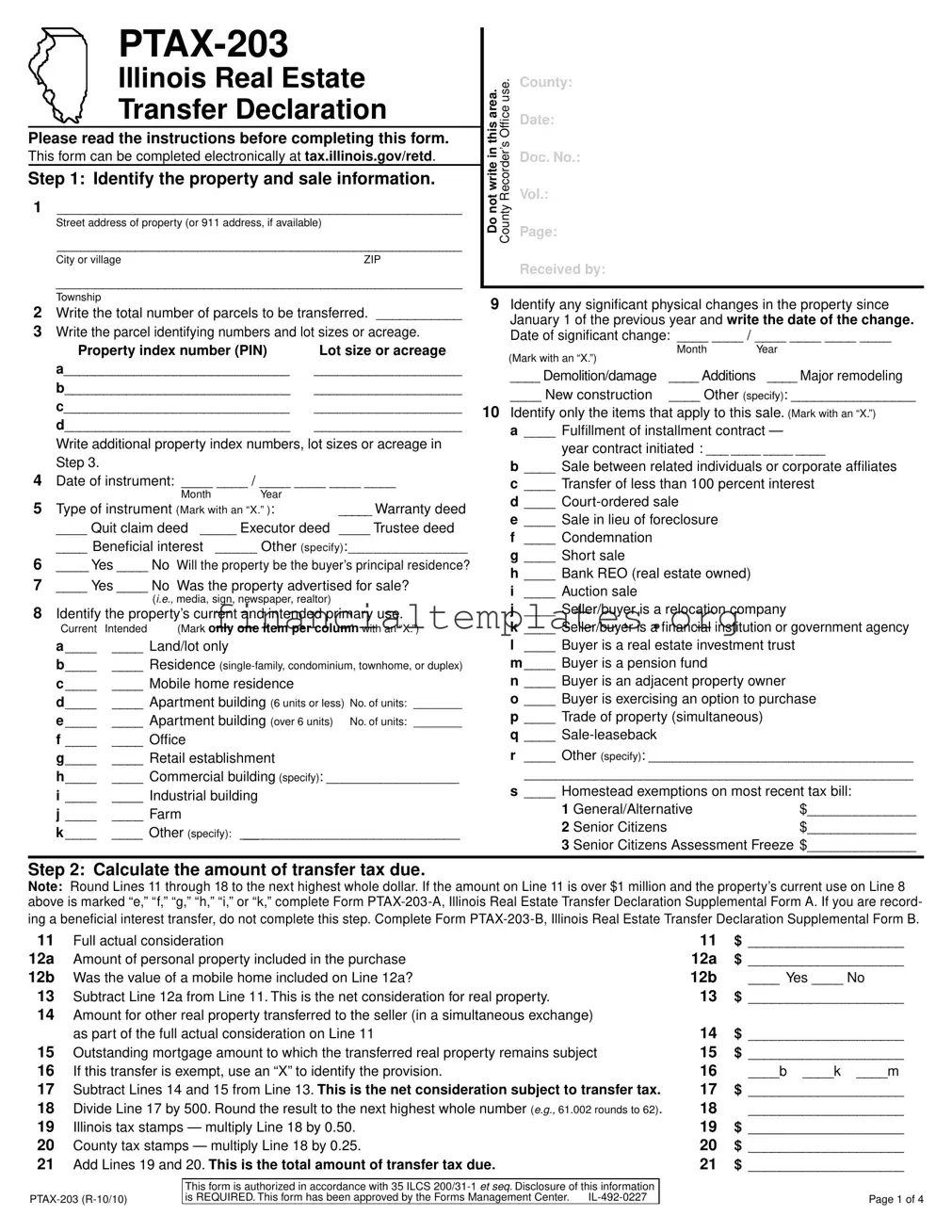Line 9 — Use an “X” to identify any significant physical changes in the property since January 1 of the previous year. Write the date the change was completed or the property was damaged.
Line 10 — Select only the items that apply to this sale. A definition is provided below for all items marked with an asterisk.
Line 10a, Fulfillment of installment contract — The installment contract for deed is initiated in a calendar year prior to the calendar year in which the deed is recorded. Write the year the contract was initiated between the seller and buyer. Do not select this item if the installment contract for deed was initiated and the property was transferred within the same calendar year.
Line 10c, Transfer of less than 100 percent interest — The seller transfers a portion of the total interest in the property. Other owners will keep an interest in the property. Do not consider severed mineral rights when answering this question.
Line 10d, Court-ordered sale — The property’s sale was ordered by a court (e.g., bankruptcy, foreclosure, probate).
Line 10g, Short sale — The property was sold for less than the amount owed to the mortgage lender or mortgagor, if the mortgagor has agreed to the sale.
Line 10h, Bank REO (real estate owned) — The first sale of the property owned by a financial institution as a result of a judgment of foreclosure, transfer pursuant to a deed in lieu of foreclosure, or con- sent judgment occurring after the foreclosure proceeding is complete.
Line 10k, Seller/buyer is a financial institution — “Financial institu- tion” includes a bank, savings and loan, credit union, Resolution Trust Company, and any entity with “mortgage company” or “mortgage corporation” as part of the business name.
Line 10o, Buyer is exercising an option to purchase — The sale price was predicated upon the exercise of an option to purchase at a predetermined price.
Line 10p, Trade of property (simultaneous) — Buyer trades or exchanges with the seller one or more items of real estate for part or all of the full actual consideration (sale price) on Line 11.
Line 10r, Other — Explain any special facts or circumstances involv- ing this transaction that may have affected the sale price or sale agreement or forced the sale of the property. This includes property that is subject to an existing lease or property that is part of an IRC §1031 Exchange.
Line 10s, Homestead exemptions on most recent tax bill — Write the dollar amount for any homestead exemption reflected on the most recent annual tax bill.
Step 2: Calculate the amount of transfer tax due.
Round Lines 11 through 18 to the next highest whole dollar.
Note: File PTAX-203-B, Illinois Real Estate Transfer Declaration Supplemental Form B, when filing instruments other than deeds, or trust documents. (Do not complete Step 2, of the PTAX-203 when filing the PTAX-203-B).
Line 11 — Write the full actual consideration (sale price). Full actual consideration is the amount actually paid, excluding any amount credited against the purchase price or refunded to the buyer for improvements or repairs to the property. Include the amount for other real estate transferred in a simultaneous exchange from the buyer to the seller, even if the transfer involves an even exchange. Also include the amount of outstanding mortgages to which the property remains subject at the time of the transfer.
Note: File PTAX-203-A, Illinois Real Estate Transfer Declaration Supplemental Form A, if the amount on Line 11 is over $1 million and the property’s current use on Line 8 is marked “Apartment building (over 6 units),” “Office,” “Retail establishment,” “Commercial building,” “Industrial building,” or “Other.”
Line 12a — Write the amount of personal property items included in the sale price on Line 11. Do not include the value of a beneficial interest of a land trust. Personal property items are generally listed on the “bill of sale.” If you are uncertain as to whether an item is real estate or personal property, consult your attorney, tax advisor, or the chief county assessment officer.
On 81/2” x 11” paper, submit an itemized list of personal property (in- clude values) transferred from the seller to the buyer if this sale meets either of the following conditions:
•residential property — if the amount of personal property (not including the value of a mobile home) on Line 12a is greater than 5 percent of the sale price on Line 11, or
•non-residential property — if the amount of personal property on Line 12a is greater than 25 percent of the sale price on Line 11.
Residential personal property — Generally, “personal property” includes items that are not attached (built-in) to the home and that are normally removed by the seller when vacating the property. Examples include artwork, automobiles and boats, draperies, furniture, free- standing appliances (e.g., refrigerators, stoves, washers and dryers, but not built-in appliances), lawn mowers, tractors, snow blowers, rugs (excludes wall-to-wall carpets), and window air-conditioners (excludes central air). Include the value of a mobile home as personal property on Line 12a if it meets all of the following conditions:
•The value of the mobile home was included on Line 11.
•The value of the mobile home was not included on the real estate tax bill.
Commercial/industrial personal property — Generally, “personal property” is any item that is not a permanent improvement to the land and includes, but is not limited to, intangibles such as goodwill, licenses, patents, franchises, business or enterprise values; and certain tangibles such as inventories, cash registers and shopping carts, free-standing shelving and displays, furniture, office equipment and supplies, vehicles, and machinery and equipment not assessed as real estate.
Generally, “personal property” does not include building components (e.g., wiring and lighting, heating, air-conditioning, plumbing, fire pro- tection); foundations, pits and other building components for special- ized or heavy machinery; permanent fixtures including, but not limited to, machinery and equipment and cranes assessed as real estate, craneways, and non-portable tanks; and site improvements such as paving and fencing.
Line 14 — Write the amount of other real estate transferred from the buyer to the seller that was included in the sale price on Line 11. This value only applies to a simultaneous exchange between the par- ties involved in this transaction. Do not include the value of property involved in a deferred exchange under IRC §1031.
Line 15 — Write an amount only if the deed or trust document states that the transferred property remains subject to a mortgage at the time of the transfer.
Line 16 — Use an “X” to identify the letter of the provision for the exemption from the transfer tax (i.e., (b), (k), or (m)) that applies to this transfer. See “Which property transfers are exempt from real estate transfer tax?” in these instructions.
Step 3: Write the legal description from the deed.
Write the legal description from the deed. Use a minimum 10-point font if the legal description is typed. If the legal description will not fit in the space provided, submit an 81/2” x 11” copy of the extended legal description from the deed with this form.
Step 4: Complete the requested information.
Write the requested information for the seller, buyer, and preparer.
Write the addresses and daytime phone numbers where the seller and buyer can be contacted after the sale.
The seller and buyer (or their agents) and preparer must sign this form. By signing the form, the parties involved in the real estate transfer verify that
•they have examined the completed Form PTAX-203,
•the information provided on this form is true and correct, and
•they are aware of the criminal penalties of law associated with falsifying or omitting any information on this form.
Use an “X” to identify any required documents submitted with this form.



